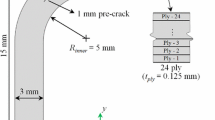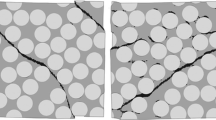Abstract
The present work aims to predict the behavior of effective elastic properties for laminated composites, considering localized damage in the interface between two layers. In practical terms, the damage in the adhesion, which influences the effective elastic properties of a laminate, is evaluated like a delamination between adjacent layers. Thus, the effective properties of laminated composites with different delamination extensions are calculated via finite element method and two-scale asymptotic homogenization method. It is investigated how the properties of the laminated composites are affected by the delamination extension and the thickness of the interface between layers. It is possible to conclude that the effective coefficient values decrease as the damage extension increases due to the fact that the delamination area increases. Besides, for all effective coefficients, except the effective coefficients \(C_{12}^*\), \(C_{13}^*\), and \(C_{23}^*\), in the case without delamination, the coefficients decrease as the adhesive region thickness increases, and almost all coefficients decrease for complete separation of the interface. Numerical and analytical results are compared in order to show the potentialities and limitations of the proposed approaches. Finally, a numerical approach is used to simulate a specific case, where the interface is considered a functionally graded material.
Similar content being viewed by others
References
Ashari, S.E., Mohammadi, S.: Delamination analysis of composites by new orthotropic bimaterial extended finite element method. Int. J. Numer. Methods Eng. 86, 1507–43 (2011)
Aghdam, M.M., Falahatgar, S.R.: Micromechanical modeling of interface damage of metal matrix composites subjected to transverse loading. Comput. Struct. 66, 415–20 (2004)
Bonora, N., Ruggiero, A.: Micromechanical modeling of composites with mechanical interface—Part II: damage mechanics assessment. Compos. Sci. Technol. 66, 323–32 (2006)
Aghdam, M.M., Falahatgar, S.R., Gorji, M.: Micromechanical consideration of interface damage in fiber reinforced Ti-alloy under various combined loading conditions. Compos. Sci. Technol. 68, 3406–11 (2008)
Fang, Q.H., Jin, B., Liu, Y., Liu, Y.W.: Interaction between screw dislocations and inclusions with imperfect interfaces in fiber-reinforced composites. Acta Mech. 203, 113–125 (2009)
Mahmoodi, M.J., Aghdam, M.M., Shakeri, M.: Micromechanical modeling of interface damage of metal matrix composites subjected to off-axis loading. Mater. Des. 31, 829–36 (2010)
Escarpini Filho, R.S., Marques, S.P.C.: A model for homogenization of linear viscoelastic periodic composite materials with imperfect interface. Lat. Am. J. Solids Struct. 13, 2706–2735 (2016)
Almeida, J.H.S., Ribeiro, M.L., Tita, V., Amico, S.C.: Damage and failure in carbon/epoxy filament wound composite tubes under external pressure: experimental and numerical approaches. Mater. Des. 96, 431–38 (2016)
Almeida, J.H.S., Ribeiro, M.L., Tita, V., Amico, S.C.: Damage modeling for carbon fiber/epoxy filament wound composite tubes under radial compression. Compos. Struct. 160, 204–210 (2017)
Voyiadjis, G.Z., Kattan, P.I.: Introducing damage mechanics templates for the systematic and consistent formulation of holistic material damage models. Acta Mech. 228, 951–990 (2017)
Lu, H., Guo, L., Liu, G. et al.: Progressive damage investigation of 2.5D woven composites under quasi-static tension. Acta Mech. (2018). https://doi.org/10.1007/s00707-017-2024-z
Yam, L.H., Wei, Z., Cheng, L., Wong, W.O.: Numerical analysis of multi-layer composite plates with internal delamination. Comput. Struct. 82, 627–37 (2004)
Alfaro, M.V.C., Suiker, A.S.J., Borst, R., Remmers, J.J.C.: Analysis of fracture and delamination in laminates using 3D numerical modelling. Eng. Fract. Mech. 76, 761–80 (2009)
Wang, R.G., Zhang, L., Zhang, J., Liu, W.B., He, X.D.: Numerical analysis of delamination buckling and growth in slender laminated composite using cohesive element method. Comput. Mater. Sci. 50, 20–31 (2010)
Simon, J.W., Stier, B., Reese, S.: Numerical analysis of layered fiber composites accounting for the onset of delamination. Adv. Eng. Softw. 80, 4–11 (2015)
Hirwani, C.K., Panda, S.K., Mahapatra, T.R., Mandal, S.K., Mahapatra, S.S., De, AK.: Delamination effect on flexural responses of layered curved shallow shell panel-experimental and numerical analysis. Int. J. Comput. Methods (2017). https://doi.org/10.1142/S0219876218500275
Thai, T.Q., Rabczuk, T., Zhuang, X.: Numerical study for cohesive zone model in delamination analysis based on higher-order B-spline functions. J. Micromech. Mol. Phys. (2017). https://doi.org/10.1142/S2424913017500047
Tran, Q.T., Toumi, A., Turatsinze, A.: Delamination of thin bonded cement-based overlays: analytical analysis. Mater. Struct. 44, 43–51 (2011)
Song, M.C., Sankar, B.V., Subhash, G., Yen, C.F.: Analysis of mode I delamination of z-pinned composites using a non-dimensional analytical model. Composites Part B 43, 1776–84 (2012)
Kargarnovin, M.H., Ahmadian, M.T., Jafari-Talookolaei, R.-A., Abedi, M.: Semi-analytical solution for the free vibration analysis of generally laminated composite Timoshenko beams with single delamination. Composites Part B 45, 587–600 (2013)
Ojo, S.O., Ismail, S.O., Paggi, M., Dhakal, H.N.: A new analytical critical thrust force model for delamination analysis of laminated composites during drilling operation. Composites Part B 124, 207–17 (2017)
Saoudi, J., Zitoune, R., Gururaja, S., Salem, M., Mezleni, S.: Analytical and experimental investigation of the delamination during drilling of composite structures with core drill made of diamond grits: X-ray tomography analysis. J. Compos. Mater. 52, 1281–1294 (2017)
Brito-Santana, H., De Medeiros, R., Ferreira, A.J.M., Rodríguez-Ramos, R., Tita, V.: Effective elastic properties of layered composites considering non-uniform imperfect adhesion. Appl. Math. Model. 59, 183–204 (2018)
Bensoussan, A., Lions, J.L., Papanicolaou, G.: Asymptotic Analysis for Periodic Structures. North-Holland, New York (1978)
Sanchez-Palencia, E.: Non-homogeneous Media and Vibration Theory (Lecture Notes in Physics, 127). Springer Verlag, Berlin (1980)
Oleinik, O.A., Panasenko, G.P.: Homogenization and asymptotic expansions for solutions of the elasticity system with rapidly oscillating periodic coefficients. Appl. Anal. 15, 15–32 (1983)
Bakhvalov, N.S., Panasenko, G.P.: Homogenization Averaging Processes in Periodic Media. Kluwer Academic Publishers, Dordrecht (1989)
Fang, Z., Sun, W., Tzeng, J.T.: Asymptotic homogenization and numerical implementation to predict the effective mechanical properties for electromagnetic composite conductor. J. Compos. Mater. 38, 1371–85 (2004)
Hassani, B., Hinton, E.: A review of homogenization and topology optimization II- analytical and numerical solutions of homogenization equations. Comput. Struct. 69, 719–38 (1998)
Zienkiewicz, O.C., Taylor, R.L.: The Finite Element Method: The Basis, vol. 1. Butterworth-Heinemann, Oxford (2000)
Bezanson, A., Karpinski, S., Shan, V.B., Edelman, A.: Julia: A fast dynamic language for technical computing. arXiv preprint arXiv:1209.5145 (2012), 292
Hughes, T.J.R.: The Finite Element Method—Linear Static and Dynamic Finite Element Analysis. Prentice-Hall, New Jersey (1987)
Geuzaine, C., Remacle, J.F.: Gmsh: a three-dimensional finite element mesh generator with built-in and pre- and post-processing facilities. Int. J. Numer. Methods Eng. 79, 1309–31 (2009)
Tita, V., Carvalho, J., Vandepitte, D.: Failure analysis of low velocity impact on thin composite laminates: experimental and numerical approaches. Compos. Struct. 83, 413–28 (2008)
Verbis, J.T., Kattis, S.E., Tsinopoulos, S.V., Polyzos, D.: Wave dispersion and attenuation in fiber composites. Comput. Mech. 27, 244–52 (2001)
Author information
Authors and Affiliations
Corresponding author
Additional information
Publisher's Note
Springer Nature remains neutral with regard to jurisdictional claims in published maps and institutional affiliations.
Rights and permissions
About this article
Cite this article
Brito-Santana, H., Christoff, B.G., Mendes Ferreira, A.J. et al. Delamination influence on elastic properties of laminated composites. Acta Mech 230, 821–837 (2019). https://doi.org/10.1007/s00707-018-2319-8
Received:
Revised:
Published:
Issue Date:
DOI: https://doi.org/10.1007/s00707-018-2319-8




